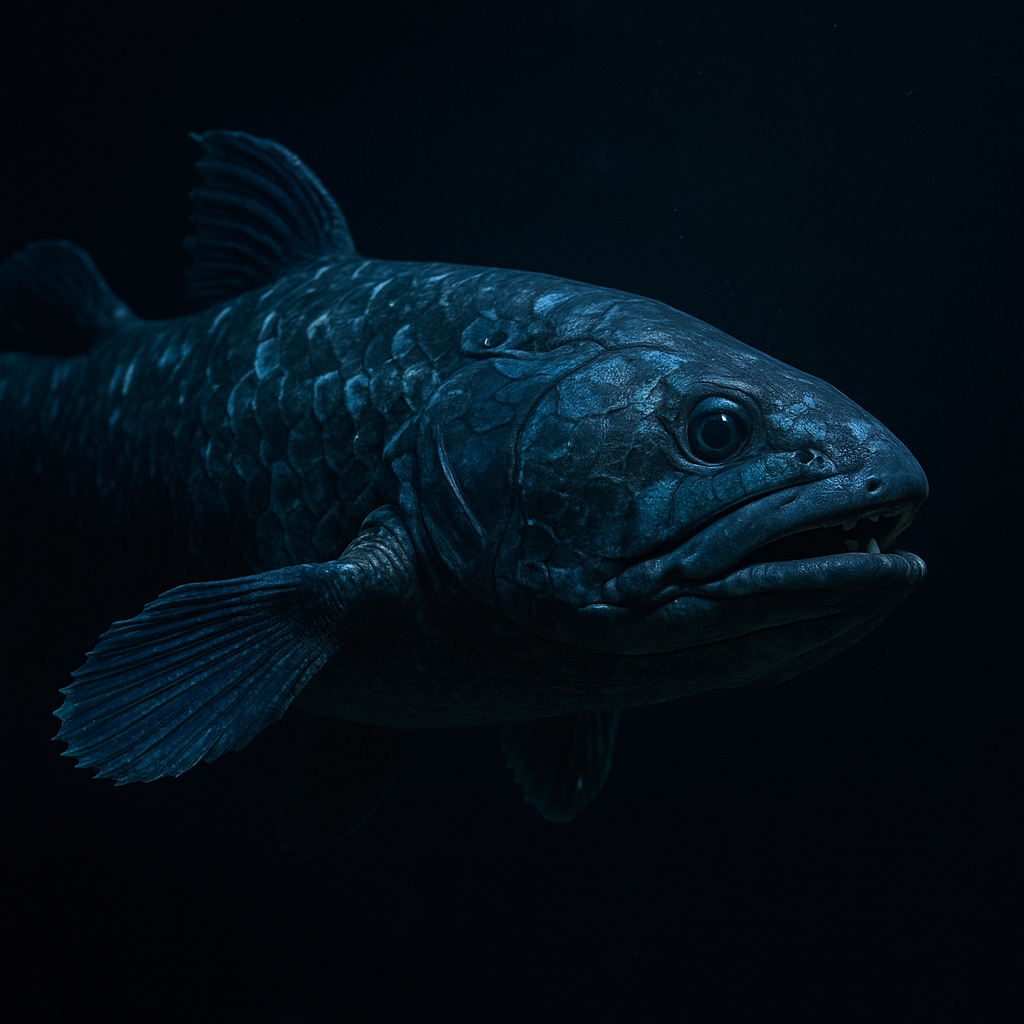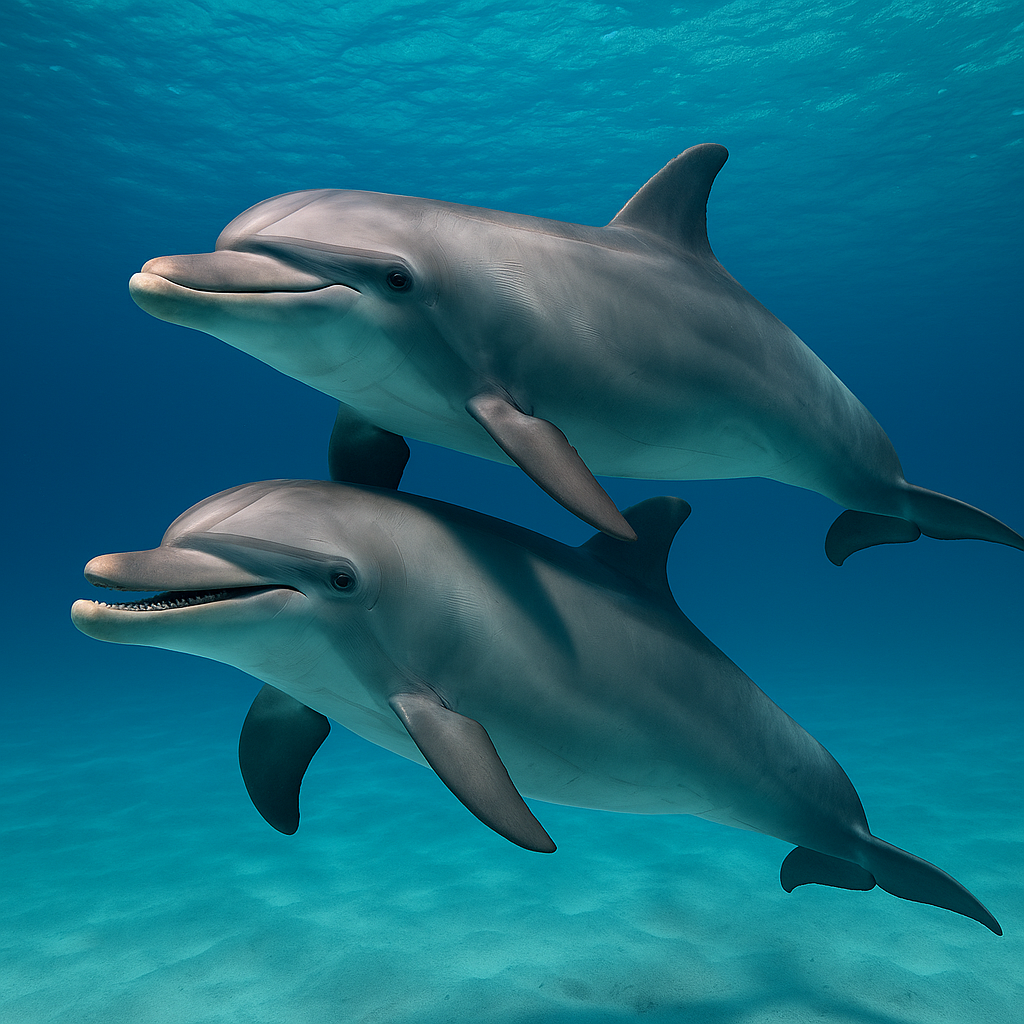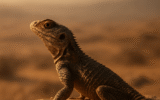In the deepest reaches of the sea, where sunlight falters into endless twilight, drifts a creature so improbable that it feels like myth. The Coelacanth (Latimeria chalumnae and Latimeria menadoensis) is a fish from another time—a survivor of cataclysms, a relic of ancient oceans, and a messenger of evolutionary memory.
For more than a century, it was known only through stone: a fossilized silhouette imprinted in rock, entombed in strata dating back over 400 million years. Science declared it extinct—erased by the same great catastrophe that swallowed the dinosaurs. And then, in 1938, a trawler off the South African coast brought up something impossible: a living coelacanth.

The discovery shook the scientific world. It was as though a ghost had swum out of stone and into our nets. The newspapers called it a “living fossil,” but that phrase diminishes its significance. The Coelacanth is not a fossil at all. It is a lifeform still writing its story, one scale at a time, across an oceanic canvas older than humanity itself.
Anatomy of an Evolutionary Relic
The Coelacanth is instantly recognizable, yet defies easy description. It can grow over 2 meters long and weigh nearly 90 kilograms, yet its body is an odd fusion of primitive and advanced.
- Lobed Fins: Unlike most fish, its paired fins are fleshy and jointed, resembling primitive limbs. These fins move in a cross-pattern—the same gait land vertebrates use when they walk. Watching a Coelacanth swim is like witnessing the rehearsal of the very first steps onto land.
- Hinged Skull Joint: Its skull is split by an extra hinge, allowing it to swing its mouth wide open like a trapdoor, engulfing prey with startling efficiency.
- Electroreception: Within its rostral organ, the Coelacanth carries an electro-sensory system that allows it to detect the faint bioelectric fields of prey hiding in the abyssal dark.
- Armor Scales: Its scales are thick, hard, and covered in cosmine—a tissue long thought extinct. They shimmer blue or brown under light, as though armored in starlight.
Everything about its body whispers of transition. It is not simply a fish but a map of evolution’s possibilities.
Life in the Abyss
Coelacanths dwell primarily along steep volcanic slopes and submarine caves at depths of 500–700 meters. There, in the cold darkness, they hover nearly motionless, as though suspended in time.
They are slow-moving ambush hunters, rising at night toward shallower waters to feed on squid, lanternfish, and cuttlefish. Their energy-efficient drifting suits their long lifespans. Researchers believe they may live 60 to 100 years, making them among the ocean’s most enduring denizens.

Reproduction is equally unusual. Coelacanths bear live young—pups—after an extraordinarily long gestation period of nearly three years, the longest known of any vertebrate. This slow rhythm of life, while effective for survival in stable ecosystems, makes them perilously vulnerable in an era of rapid change.
The Weight of Time
To encounter a Coelacanth is to confront time itself. These fish have outlasted five mass extinctions. They swam beneath the shadows of giant ferns in the Devonian, survived the Permian extinction that annihilated most life on Earth, and persisted as dinosaurs thundered overhead.
When mammals were still tiny, shrew-like creatures scurrying in fear, the Coelacanth already patrolled the seas with calm assurance. Their survival speaks not to dominance, but to resilience. They are not conquerors of the ocean, but custodians of continuity.
Myth and Mystery
To the Comoran fishermen who long knew the Coelacanth, it was called Gombessa, a fish wrapped in mystery. Some considered it a bad omen, others a sign of ancestral spirits. In Indonesia, the second living species (L. menadoensis) is part of local lore as well.
To Western science, however, the Coelacanth was a revelation. Its rediscovery in the 20th century humbled human arrogance about knowing the natural world. If an animal thought extinct for 66 million years could appear alive and well, what else drifts in the uncharted abyss?
The Coelacanth became a symbol of the unknown—a reminder that the ocean is not merely unexplored, but largely unimaginable.
Conservation: A Fragile Survival
Ironically, what millions of years of extinctions could not erase, human activity might.
- Bycatch: Coelacanths are sometimes unintentionally caught in deep-sea gillnets and trawls, their fragile populations further reduced by accidents of human fishing.
- Habitat Change: Rising ocean temperatures and altered currents threaten the volcanic slopes and caves they inhabit.
- Slow Reproduction: Their long lifespans and slow reproductive cycles make every loss catastrophic for the species.
The International Union for Conservation of Nature (IUCN) lists the Coelacanth as Critically Endangered. Current estimates suggest only a few hundred survive in known locations.
And yet, there is hope. In Comoros and Indonesia, where they are most frequently found, fishermen now partner with scientists to report sightings rather than harvest them. Protected areas and marine research zones offer sanctuaries. The story of the Coelacanth is fragile, but still being written.
Symbolism: The Mirror of Evolution
Philosophically, the Coelacanth is more than an animal—it is a mirror. It reflects the fragility of life, the resilience of survival, and the humility of human knowledge.
Its lobed fins remind us of our own origins. Every step we take on land is an echo of fins that learned to push against mudflats hundreds of millions of years ago. Its survival is not grandeur, but persistence—proof that the quiet endurance of life is often more powerful than the loud march of extinction.
Conclusion: Keeper of Secrets
The Coelacanth drifts in silence, a sentinel of the abyss. It is not merely a relic of what once was, but a witness to all that has been, and perhaps, a guardian of what may still be.
Its presence asks us uncomfortable questions:
- If this creature could endure unseen for so long, what else hides in the black waters?
- What truths about resilience and survival have we yet to learn from the ocean?
It teaches us that history is not locked in stone, but alive and swimming, if we have the patience to look.
The Coelacanth is not the past. It is the persistence of life itself, shimmering quietly in the deep.


Reply